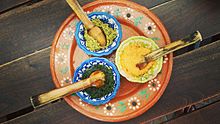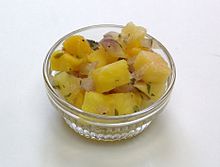Salsa (food)
 A variety of salsas | |
| Type | Sauce, Dip, Condiment |
|---|---|
| Region or state | Mexico |
| Main ingredients | Varies |
Salsa is the Spanish word for "sauce".
In English, especially in the United States, when the word "salsa" is used, it refers to the spicy tomato-and-chili-based preparation found in Mexican, Texan, Central American and South American cuisine. It is commonly used as a dip alongside tortilla chips, or as a condiment served along with dishes such as huevos rancheros or burritos.
In the Hispanophone world, there are hundreds of different kinds of salsas made with varied ingredients such as green peppers, tomatoes, jalapenos, onion, cilantro, garlic, lemon juice, lime juice, dill, red peppers. Some salsas include less commonly used ingredients like cucumbers or avocado.[1]
History
The medieval Catalan[2] cookbook Libre del coch (1520) includes several salsa recipes using ingredients such as ginger, mace powder (flor de macis), cinnamon, saffron, cloves (clauells de girofle), wine and honey.[3][4]
Pronunciation and etymology
The word salsa entered the English language from the Spanish salsa ("sauce"), which itself derives from the Latin salsus (salted). The native Spanish pronunciation is [ˈsalsa]. In American English it can sometimes be pronounced with a short A sound (/ˈsælsə/) especially in regions further North, while in British English it is pronounced with a long A sound (/ˈsɑːlsə/.)
Types


Mexican salsas were traditionally produced using the mortar and pestle-like molcajete, although blenders are now more commonly used. The Maya made salsa also, using a mortar and pestle. Well-known salsas include:
- Salsa roja, one of the two most common and well known types of salsa, "red sauce", is used as a condiment in Mexican and Southwestern (U.S.) cuisines; usually includes cooked tomatoes, chili peppers, onion, garlic, and fresh cilantro (coriander).
- Pico de gallo ("rooster's beak"), also known as salsa fresca ("fresh sauce"), salsa picada ("chopped sauce"), or salsa mexicana ("Mexican sauce"), is made with raw tomatoes, lime juice, chilies, onions, cilantro leaves, and other coarsely chopped raw ingredients.
- Salsa cruda, "raw sauce", is an uncooked mixture of chopped tomatoes, onions, jalapeño chilies, and cilantro.[5]
- Salsa verde, "green sauce", in Mexican versions, is made with tomatillos, usually cooked.
- Salsa negra, the other most common and well known type of salsa, "black sauce" is a Mexican sauce made from dried chilies, oil, and garlic.
- Salsa taquera, "taco sauce": Made with tomatillos and morita chili. In the U.S., the most common version contains tomato puree, vinegar, and chili pepper.
- Salsa criolla is a South American salsa with a sliced-onion base.
- Salsa ranchera, "ranch-style sauce": Made with roasted tomatoes, various chilies, and spices, it typically is served warm, and possesses a thick, liquidy quality. It imparts a characteristic flavor reminiscent of black pepper, though it often may not contain black pepper.
- Creamy avocado salsa is a sauce made from avocado, lime, cilantro, jalapeño or serrano peppers, garlic, olive oil, cumin, and salt.
- Mango salsa is a spicy-sweet sauce made from mangoes, used as a topping for nachos. It is often also used as a garnish on grilled chicken or grilled fish due to the sauce's gamut of complementary flavors.
- Pineapple salsa is a spicy and sweet sauce made from pineapples, used as an alternative to the mango salsa.
- Chipotle salsa is a smoky, spicy sauce made from smoked jalapeño chilies, tomatoes, garlic and spices.
- Habanero salsa is an extremely spicy salsa, where the piquancy comes from habanero chilies.
- Corn salsa is a chunky salsa made with sweetcorn and other ingredients, such as onions, and chiles (either poblano, bell chilies, and/or jalapeños). Made popular by burrito restaurant chains, for burritos, tacos, and quesadillas.
- Carrot salsa is made with carrots as the base.[6]

There are many other salsas, both traditional and nouveau, some are made with mint, pineapple, or mango.
Outside Mexico and Central America, the following salsas are common to each of the following regions; in Argentina and the Southern Cone, chimichurri sauce is common. Chimichurri is "a spicy vinegar-parsley sauce that is the salsa (and leading condiment) in Argentina and Uruguay, served with grilled meat. It is made of chopped fresh parsley and onion, seasoned with garlic, oregano, salt, cayenne chilies and black pepper and bound with oil and vinegar."[7] In Costa Rica, dishes are prepared with salsa Lizano, a thin, smooth, light brown sauce. In Cuba and the Caribbean, a typical salsa is mojo. Unlike the tomato-based salsas, mojo typically consists of olive oil, garlic, and citrus juice, and is used both to marinate meats and as a dipping sauce.
Prepared salsa
This section needs additional citations for verification. (December 2019) |
Most jarred, canned, and bottled salsa and picante sauces sold in the United States in grocery stores are forms of salsa cruda or pico de gallo, and typically have a semi-liquid texture. To increase their shelf lives, these salsas have been cooked to a temperature of 175 °F (79 °C), and are thus not truly cruda (raw). Some have added vinegar, and some use pickled peppers instead of fresh ones. Tomatoes are strongly acidic by nature, which, along with the heat processing, is enough to stabilize the product for grocery distribution.
Picante sauce of the American type is often thinner in consistency than what is labelled as "salsa". Picante is a Spanish adjective meaning "piquant", which derives from picar ("to sting"), referring to the feeling caused by salsas on one's tongue.
Many grocery stores in the United States and Canada also sell fresh refrigerated salsa, usually in plastic containers. Fresh salsa is usually more expensive and has a shorter shelf life than canned or jarred salsa. It may or may not contain vinegar.
Taco sauce is a condiment sold in American grocery stores and fast food Tex-Mex outlets. Taco sauce is similar to its Mexican counterpart in that it is smoothly blended, having the consistency of thin ketchup. It is made from tomato paste instead of whole tomatoes and lacks the seeds and chunks of vegetables found in picante sauce.
While some salsa fans do not consider jarred products to be real salsa cruda, their widespread availability and long shelf life have been credited with much of salsa's enormous popularity in states outside the southwest, especially in areas where salsa is not a traditional part of the cuisine. In 1992, the dollar value of salsa sales in the United States exceeded those of tomato ketchup.[8]
Importance of proper storage

The World Health Organization says care should be taken in the preparation and storage of salsas and any other types of sauces, since many raw-served varieties can act as growth media for potentially dangerous bacteria, especially when unrefrigerated.[9]
In 2002 a study by the University of Texas–Houston, found sauces contaminated with E. coli in:
- 66% of the sauces from restaurants tested in Guadalajara, Jalisco, Mexico
- 40% of those from restaurants tested in Houston, Texas[10]
In 2010 the CDC reported that 1 in 25 foodborne illnesses between 1998 and 2008 was traced back to restaurant sauces (carelessly prepared or stored).[11]
A 2010 paper on salsa food hygiene described refrigeration as "the key" to safe sauces. This study also found that fresh lime juice and fresh garlic (but not powdered garlic) would prevent the growth of Salmonella.[12]
See also
References
- ^ Taste of Home, Recipe Card Collection, Volume 5, 2004
- ^ Scholliers, Peter (2012). Writing Food History: A Global Perspective.
- ^ Lybre de doctrina Pera ben Servir: de Tallar: y del Art de Coch
- ^ Alimentació i societat a la Catalunya medieval. CSIC Press. 1998.
- ^ "salsa cruda - food". Encyclopædia Britannica.
- ^ Gentry, Ann; Head, Anthony (2005). Real Food Daily Cookbook: Really Fresh, Really Good, Really Vegetarian. Ten Speed Press. p. 64. ISBN 1-58008-618-7.
- ^ "Types Of Salsa". Thenibble.com. Retrieved 2012-07-11.
- ^ "Ketchup? Catsup? Ke-cap? / Whatever the name, a squirt of red can change everything". SFGate.
- ^ Larry R. Beuchat. "Surface decontamination of fruits and vegetables eaten raw: a review" (PDF). World Health Organization. Archived from the original (PDF) on April 5, 2011. Retrieved July 22, 2010.
- ^ Javier A. Adachi, John J. Mathewson, Zhi-Dong Jiang, Charles D. Ericsson, and Herbert L. DuPont. Annals of Internal Medicine, June 2002, Vol. 136, pp. 884–887.
- ^ "Salsa and Guacamole Increasingly Important Causes of Foodborne Disease". Retrieved July 23, 2010.
- ^ Ma L; Zhang G; Gerner-Smidt P; Tauxe RV; Doyle MP (March 2010). "Survival and growth of Salmonella in salsa and related ingredients". J. Food Prot. 73 (3): 434–44. PMID 20202327.
External links
- U.S. National Center for Home Food Preservation – Salsas
- Salsa Recipes
- "History of Salsa". Gourmet Sleuth. Retrieved August 17, 2006.













